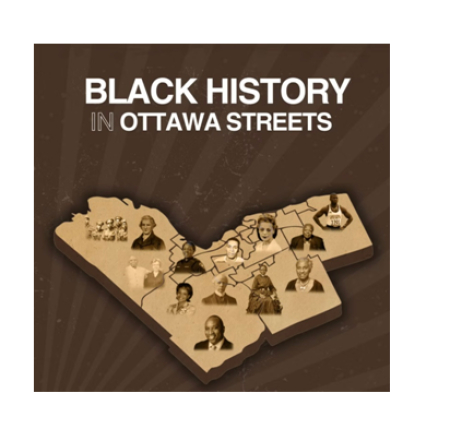If you didn’t have a chance to hop aboard Black History Ottawa’s excellent bus tour last summer then grab a seat now. The Historical Society of Ottawa is proud to partner with Black History Ottawa for a virtual re-creation of the tour. The bus leaves on Wednesday, February 12, 2025 at 19:00, or anytime through the link below. Our driver tonight is Jean-Marie Guerrier.
Jean-Marie is a cardiology technologist at the Ottawa Heart Institute. He is a member of the Board of Flo’s Seniors Health and Care Programs Network and has more than 25 years of volunteering in Montreal and Ottawa. Jean-Marie’s name is now inscribed on Ottawa’s Wall of Inspiration at City Hall and he is also the Vice-President of Black History Ottawa.
The bus tour evolved from an earlier project that looked at slavery in Canada and how it remains today embedded in the street names in Ottawa. It was felt that a broader project that highlighted the accomplishments and contributions of Canadians of African descent would shift the focus to the positive and be an inspiration to younger Canadians.
The first stop for our virtual bus was Notre Dame Basilica, where we have evidence of the first Black family recorded in Bytown. In 1844, Perry Adams and Henrietta Joyce baptized their child Frances. A few steps down Sussex Drive we find the Royal Canadian Mint, which has produced a number of coins that highlight the contributions of Black Canadians or events of historic importance. These include: Willie O’Ree, Oscar Peterson, the Black Loyalists, and the Underground Railroad, among others. Jean-Marie noted that the Bank of Canada produced a vertical $10 bill in 2018 featuring a portrait of Viola Desmond. Viola was a Black business woman from Halifax who, in 1946, was arrested, jailed overnight, and fined for sitting in the whites-only section of the Roseland Theatre in New Glasgow. Her appeal to the Nova Scotia Supreme Court was unsuccessful, serving as a catalyst to the Civil Rights movement in Canada.
We swing briefly up to the Canada Post building on Sparks Street, where Jean-Marie tells us of some of the Black Canadians that Canada Post has featured on their stamps. These include: Albert Jackson, Mathieu Da Costa, and Chloe Cooley. We then popped over to Osgoode Street in Sandy Hill where Jean-Marie told us Chloe Cooley’s tragic story. Osgoode Street is named for William Osgoode, who on December 31, 1791, was named the first Chief Justice of Upper Canada. In March 1793, Chloe Cooley, a young Black slave, was, despite her struggles and calls for help, bound and taken across the Niagara River to New York State and sold by her enslaver. What happened to her after is unknown. On July 9th 1793, during Osgoode’s term, legislation was passed to limit, but not abolish, slavery in Upper Canada.
From here, Jean-Marie drove us to Rockcliffe Lookout, where we could see across the Ottawa River to lands where London Oxford, the first Black settler in the area arrived in March 1800 as one of the five families in the party led by Philemon Wright. It is unclear if he was alone or if he had a family with him. On June 11, 1806, London was one of the five men who took the first timber raft down the Ottawa River and then on to Quebec City.
From there we travelled to the Lord Elgin Hotel where Jean-Marie gave us some background on the Underground Railroad. Between 1800 and 1865, this secret network of routes and safe-houses allowed some 30,000 escaped slaves to make their way to Canada. In 1847, Lord Elgin was appointed as the first Governor-General of the Province of Canada, and two years later, Reverend William King established the Elgin Settlement (aka Elgin-Buxton Settlement), in his name in southwestern Ontario. It was one of the last stops on the Underground Railroad and now a National Historic Site. In the second half of the 1800s many other Black settlements were established across Canada, including in both British Columbia and Alberta.
In Lowertown, Jean-Marie told us the fascinating story of Paul Barber and the Barber family. Born into slavery, Paul was sold to the Barber family in 1852 at age 4. They were horse breeders and trainers in Kentucky and taught Paul the skills. In 1885 he moved to Ottawa and in 1892 married Elizabeth Brown, a white woman from Renfrew County, this being the first known inter-racial marriage in Ottawa.
We then stopped at Laurier House, former residence of Prime Minister Sir Wilfred Laurier, who was responsible for Order-in-Council PC 1911-1324, which was approved on August 12, 1911, and prohibited immigration of Blacks to Canada and declared that they were unsuitable to the climate and requirements of Canada.
Jean-Marie had us “get off the bus” at the National War Memorial so we could learn more about the contributions of Black Canadians in the Canadian military. During both World Wars Black Canadians faced and fought racism in the recruiting practices of the Canadian military. Despite these challenges, during the First World War some 1,300 Black Canadians served in the Canadian Expeditionary Force. They participated in many actions, including the battle of Vimy Ridge. On July 5th 1916, Canada formed the 2nd Construction Battalion, a Black unit lead by white Officers, four of these Officers being from Ottawa. In the Second World War, thousands of Black Canadians joined the armed forces and served throughout Europe. They continued to serve with distinction in the Korean Conflict through to today. Nearby there are also relevant memorials which relate to those who served during the American Revolutionary war and the war of 1812,. To learn more stories of Black Canadian Veterans, please visit: Black History | Black Canadian Veterans Stories
We made a quick stop at Browns Cleaners where we learnt the story of Herbert “Pops” Brown and his wife Estelle. Herbert came to Canada in 1937, serving in the Canadian army between 1939 and 1942. His family joined him in Canada in 1953 and they moved first to Hull and then to Ottawa opening Brown’s Cleaners and Tailors on Murray Street in 1957. Having worked through the immigration challenges themselves, the Browns opened their home and business to support newcomers from the Caribbean and Africa. The nickname “Pops” arose as Herbert was a stand-in father at some weddings of young women who had come to Ottawa under the West Indian Domestic Scheme. Estelle often made the dresses. The family sold the business in the late 1970s but asked that the new owners retain the name.
Next, Jean-Marie took us to the old Union Station, currently the home of the Senate. It served as Ottawa’s railway station until 1966. This site is important for a couple of reasons. On April 27, 1954, Donald Moore led a delegation to Ottawa to meet with the Minister of Citizenship and Immigration Walter Harris. The discussions, related to Canada’s discriminatory immigration policy, eventually leading to the government adopting the West Indian Domestic Scheme a year later. See: West Indian Domestic Scheme (1955–1967) National Historic Event. The railways are of special significance to the Black community as many Black men were employed as porters or sleeping car porters, to serve the railway’s passengers. Portering was one of the few employment opportunities for Black men prior to the 1950s. Pay and working conditions were poor, eventually leading the porters to unionize for improved conditions.
The West Indian Domestic Scheme shows up again as Jean-Marie took us to the YM/YWCA. The YM/YWCA, though not at this location at the time, was the meeting place for many of the young women who had come to Ottawa through the scheme. They met on Thursday afternoons, their only time off from their 7-day work week, to share companionship and information. These women, once liberated from their domestic service contracts, went on to advance their education, open businesses, and establish many of the social and community organizations directed to Caribbean immigrants in Ottawa. The current YM/YWCA stands on the site of the old Ottawa Auditorium, where the Hull-Ottawa Canadians played some of their home games. Willie O’Ree, the first Black player in the NHL, was a member of this team after being traded from the Boston Bruins to the Montreal Canadians who owned the team. He was sent down to the Hull-Ottawa minor league team without being given a chance to play for Montreal.
We next stopped at the statue of Oscar Peterson beside the National Arts Centre, where Jean-Marie challenged us to guess the occupations of Oscar’s mother and father. Not surprisingly, based on what we had learnt so far, his mother was a domestic worker and his father was a porter. Born in Montreal, he was a world-famous musician and activist. One of his compositions, the 1963 Hymn to Freedom, was widely adopted by Civil Rights movements around the world: Oscar Peterson - Hymn To Freedom
We made a series of other stops along the way, one at the Public Service Alliance Commission, where we heard about Cal Best, a noted union organizer and activist. At the Ottawa Police station on Elgin Street, Jean-Marie told us a bit about the first Black officers who joined the service in the 1970s, the first Black women who joined the service in the 1990s, and Peter Sloly, the first Black Police Chief in Ottawa, who held the position from October 2019 to February 2022. We then moved to City Hall, where we acknowledged Rawlston King, who became the first Black City Councillor in Ottawa, 164 years after its incorporation. Jean-Marie also told us of some Black Ottawans who have received the Order of Ottawa and of the Black athletes in the Ottawa Sports Hall of Fame, including Olympic Gold Medalist Glenroy Gilbert. We then paused at Nelson Mandela Square on Elgin Street across from the Human Rights monument. This was dedicated on Thursday July 17th 2014 in recognition of his life-long dedication to democracy and human rights.
From there we moved to the University of Ottawa where Jean-Marie gave us some information on a couple of remarkable health care professionals. Myrtha Lapierre was the first Black Francophone woman in the Nursing Program at the U of O, earning both a B.A. and an M.A. She taught nursing in hospitals and at Algonquin College between 1961 and 1997 and was very active in empowering immigrant women in Ottawa. The City of Ottawa declared October 25, 2008, as “Myrtha Lapierre Day” and in 2018 she was appointed to the Order of Ontario. The second person mentioned was Dr. Rudy Gittens, long-time doctor for many of our local sports teams including the Ottawa Gee-Gees, the 67s, the Rough Riders and the National Men’s Soccer team among others.
Our final two stops were at Rideau Hall where Jean-Marie told us a bit about the Right Honourable Michaëlle Jean. After arriving in Canada as a refugee in 1968, she completed her education before serving as a journalist with both Radio-Canada and the CBC. She served as the 27th Governor-General of Canada between 2005 and 2010. In 2010 she was appointed as the Special Envoy for Haiti for the United Nations Educational, Scientific and Cultural Organization and from 2015 to 2018 served as the Secretary-General of the Organisation internationale de la Francophonie.
As we slow down at the end of our journey we pass Parliament Hill, where Jean-Marie highlighted the careers of several Black MPs including Jean Augustine and Lincoln Alexander. Jean Augustine was born in Granada and came to Canada in 1960 under the West Indian Domestic Scheme. Following her contract she obtained a teacher’s certificate in Toronto, followed by a B.A. and an M.A. in Education from the University of Toronto. After working as a teacher and school principal she entered federal politics, becoming the first Black woman elected to Parliament. She served as the Parliamentary Secretary to Prime Minister Jean Chrétien from 1994 to 1996. From 2002 to 2004, she became the first Black woman to hold a Cabinet position, serving as the Minister of State for Multiculturalism and the Status of Women. In 1995 she introduced the Bill in the House of Commons that eventually led to February being officially recognized as Black History Month. Lincoln Alexander was the first Black Canadian Member of Parliament in 1968. In 1979 he became the first Black Cabinet Minister and on September 9, 1985, he became the 24th Lieutenant-Governor of Ontario, the first Black Canadian to hold such a position anywhere in the country.
You can view Jean-Marie’s full presentation, which contains many further examples, at: Black History in Ottawa Streets
The virtual tour is only a sample of the real thing, so put aside some time this summer to hop on the real bus for the full experience.






